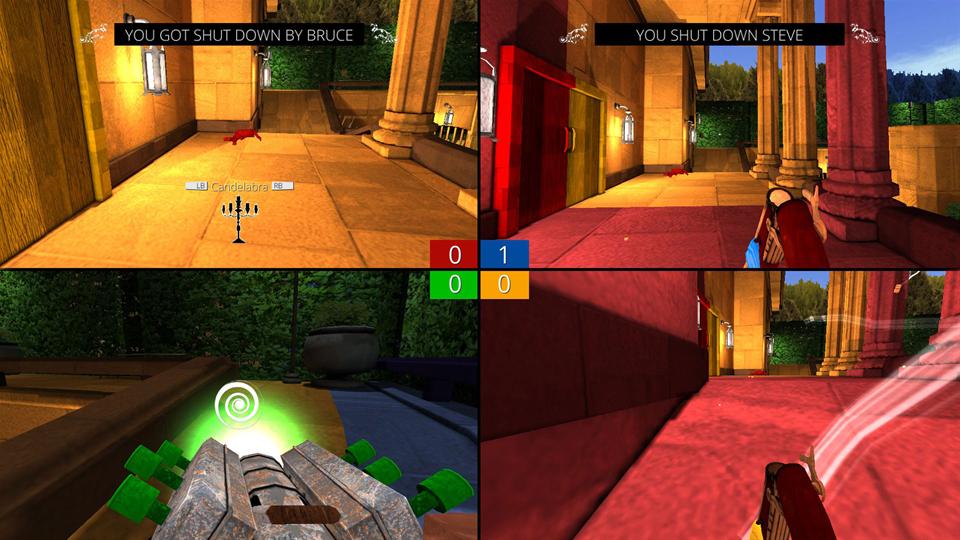Screencheat dev: how to make invisible kills impactful

Samurai Punk founder Nicholas McDonnell is in his element at GDC. This time last year he’d just graduated university, but interest was already starting to build around the Australian studio’s unusual split-screen shooter Screencheat.

The three-strong studio developed Screencheat remotely between Sydney and Melbourne, but nowadays Samurai Punk has its own office space in Melbourne. Better still, McDonnell is on the other side of the world demoing the forthcoming Xbox One edition of his game. While Screencheat will hit consoles this year, improvements continue on the PC front: in addition to a new patch last month, an eight-player split-screen mode is rolling out soon, effectively doubling the chaos.
How did the studio pull the concept off in under a year? Screencheat grew from a January 2014 game jam bearing the theme “we don’t see the world as it is, we see the world as we are”. Then, ten months later, it hit Steam. The team originally conceived a puzzle-based competitive game where each player would experience the same world differently, but lacking the time needed to implement networking capabilities, they toyed with the idea of split-screen.
There was one major problem, though: screencheating would totally ruin the experience. It was impossible to implement the puzzle idea, but out of this problem emerged a game built entirely around the mechanic.
“There were a handful of major issues,” McDonnell says of the game’s development. “I now know why big companies and big Triple A studios aren’t doing split-screen anymore: it’s a huge performance sink. It’s four times the graphics power required to render all those extra assets, because you need four cameras and they’re all doing the exact same amount of work. I wasn’t going to let the game release if it didn’t run fast. It’s a shooter so it needs to be slick.”
The other major issues were related to design. How do you design levels based on the theme that all players are invisible? How do you create environments readable enough to allow for strategy and, most importantly, actual kills?
“It was such a challenge,” McDonnell said. “It’s a whole new way of thinking about level design because every piece of space needs to communicate information, and the physical spaces need to be small because otherwise players will get lost on the opponent’s screen. Space needed to be navigable as well as communicable, in a way that isn’t common to most games. It needs to communicate location down to a metre or a half-metre.”
The biggest gaming news, reviews and hardware deals
Keep up to date with the most important stories and the best deals, as picked by the PC Gamer team.
"When you shoot you reveal your position, and you have to get into cover, otherwise you’re dead”
The team achieved this readability with tight colour-coded arenas sprinkled with unique landmarks. The concept sounds confusing on paper but thanks to the level design it works, an admirable feat for a young team with no previous design documents to consult.
Still, no amount of clever world building can accommodate what is arguably the most important ingredient in any shooter: the satisfaction of landing a kill.
“Kills weren’t satisfying for a long time,” McDonnell said. “ One of the first things we realised was that the reload times were too short, for example. Kills meant nothing under these circumstances because players would shoot blindly and get kills at random, without knowing what they were doing.
“But this game is about knowing what you’re doing,” he continued. “You won’t find an AK47 in a game like this, you won’t find something that shoots fifty bullets a second. A shot is a decision because the reload time is such a sacrifice to your safety. When you shoot you reveal your position and you have to get into cover, otherwise you’re dead.”
While weapons were designed for maximum impact, the game’s overblown ragdoll physics were implemented to make kills more satisfying. “We have these ragdolls that spawn in when someone dies, so we had to somehow produce the same sort of visceral feeling you get when you achieve a kill in a regular shooter," McDonnell says.
"In regular shooters you’re directing your shots at a body and you’re very conscious of what you’re doing and how it’s affecting the other player. If you shoot something with an assault rifle in Halo, for example, the bullet pings off the shield and you see the shimmer on the shields, then you see the shields go away and you see you’ve almost got them, then you hit them and they’re dead.”
The team didn't have the luxury of relying on visual feedback in Screencheat. “When you shoot someone [in Screencheat] the killcam focuses on the way the ragdoll flails around. The bullets produce thirty times more force than they need to on the bodies, so if you shoot someone standing on a rail, they get hit, and the legs clip the rail and they fly head over heels over it.
"We tried to juice up the kills because you only get a couple of kills per game and you don’t get the [visual cues] before that, so when you get a kill you need to feel like you got it good.”
With the eight-player patch rolling out in late May, the small team intends to continue supporting Screencheat while working on new prototypes in their downtime.
“It’s a really positive community,” McDonnell says of Screencheat’s small-but-focussed following. “Because it’s a new design and a new approach to a genre, we have a lot of people coming in with new ideas and new designs. It’s great for us because people are able to provide ideas which we hadn’t thought of.”

Shaun Prescott is the Australian editor of PC Gamer. With over ten years experience covering the games industry, his work has appeared on GamesRadar+, TechRadar, The Guardian, PLAY Magazine, the Sydney Morning Herald, and more. Specific interests include indie games, obscure Metroidvanias, speedrunning, experimental games and FPSs. He thinks Lulu by Metallica and Lou Reed is an all-time classic that will receive its due critical reappraisal one day.

